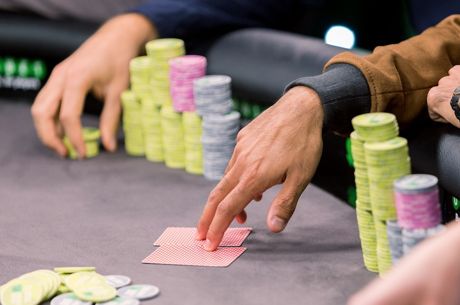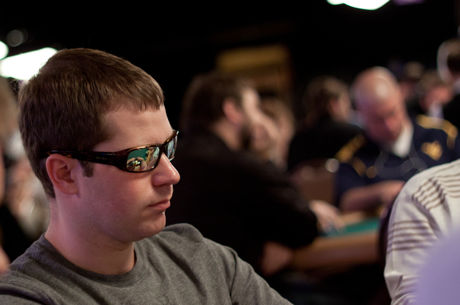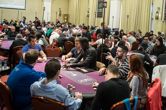10 More Hold'em Tips: Making the Squeeze Play

The "squeeze play" is an example of a preflop bluff, although it's a bit more involved than simply betting or raising with a weak hand versus a lone opponent. In fact, the squeeze play is a somewhat advanced move, requiring a little extra savvy and know-how to pull off successfully.
The easiest way to define a squeeze play is via an example. It's a $2/$5 no-limit hold'em cash game, and a player in middle position opens with a raise to $20. It folds around to the player on the button who calls the raise. The small blind next folds, then the player in the big blind puts in a reraise to $95.
The middle position player who had originally raised folds as does the caller on the button, and the big blind wins the pot.
The reraise by the big blind is considered a squeeze play because of the way his reraise puts different kinds of pressure on both of his opponents — in a way, "squeezing" both of the other players out of the hand.
The original raiser in middle position might have called a three-bet if it were heads-up, but since he's worried about the other player still to act on the button, he folds instead. Meanwhile the player on the button who just called the original raise has already demonstrated he probably isn't holding a premium hand (with which he'd reraise). His hand was good enough to call a single raise, but probably not good enough versus a raise and reraise, so he, too, folds, having also been "squeezed" out of the hand.
The player in the big blind obviously could make a big reraise like this with a premium hand himself. But the squeeze play is really more about the players and the situation than the cards. When a player raises before the flop and one or more players call, the circumstances are right for anyone left to act to make the squeeze play and raise — with "any two cards" (as they say).
That said, there need to be other conditions in place before you go firing in a big reraise versus multiple opponents with your 8♣3♥.
Condition #1: You believe the original raiser isn't strong
When a player opens with a preflop raise, that could mean a number of different things. If the player is super tight and only raises with the absolute best starting hands, you probably shouldn't be trying a squeeze play in response. A preflop open from early position (e.g., under the gun or the next seat over) often represents a stronger-than-average hand, too, which makes a squeeze play bluff out of the blinds less recommended as well.
But preflop opens from middle and late positions can often indicate a wider range of hands, particularly from players who are looser and/or more aggressive. You might even have some other reason — say a tell you've noticed — to suspect the raiser isn't especially strong. In any case, before making the squeeze play, you have to be reasonably sure there's a good chance the raiser will fold to your reraise after he's raised and there is a caller or callers between you.
Condition #2: You believe the caller also doesn't hold a premium hand
In order for your squeeze play to work, you also need to be fairly certain the caller isn't holding a premium hand like aces, kings, queens, or ace-king. This is usually easier to estimate, as most players will not simply call with such hands, but reraise with them — unless, that is, they suspect a squeeze play is coming behind them (and they are setting a trap)!
Think about the kinds of hands with which players call preflop raises, especially with position — small and medium pocket pairs, suited connectors, suited aces, other "speculative" hands. Such hands make up the majority of most callers' possible range here — hands good enough to call a single raise, but not good enough to call a big reraise, too.
Condition #3: Your image makes a reraise-bluff seem unlikely
Your own image is important to consider as well before trying a squeeze play. Ideally you appear to be a straightforward or even tight player who is not inclined to bluff or get "out of line" with unorthodox moves. Think about how often you've been getting involved, what hands you've shown, and how loose and/or aggressive you might seem to others. If you're being pegged as a maniac or even just a player who likes to pressure others a lot, your squeeze play has less of a chance of being successful.
The squeeze play also tends not to work well if you've already pulled it off once before in a cash game session or at a given tournament table. In fact, even if you weren't bluffing before when you reraised out of the blinds versus a raiser and caller — say you had aces, and the others folded — that can hurt your chances of getting a squeeze through on a subsequent hand.
The Squeeze Play: Bet Sizing
One other important factor to consider when making the squeeze play — how much should you reraise?
In the example above, the player making the squeeze from the big blind made it $95 to go — that's a hefty reraise. If you go back and add up the bets in that hand, that reraise is about twice what was in the middle at that point. It also requires both of the other players to put in $75 more each after having only committed $20 to that point.
Often the squeeze play will come from the blinds, meaning the player making it would be out of position if the hand were to reach the flop. In that case, big reraises are usually needed for the play to work. If you try a squeeze play but make your reraise too small, you'll give your opponents inviting pot odds to call.
Of course, you also need to account for your opponents' stack sizes, making sure everyone is deep enough to fold to a reraise. If you're in a tournament and one of the other players is short enough to feel pot committed or at least ready to gamble by calling a squeeze, that might be a good reason not to try the play. Appropriate bet sizing can vary also between live and online poker — something else to consider when squeezing.
Remember, the primary objective of the squeeze play is to earn folds, not get to a flop with a subpar starting hand (and likely from out of position). That said, many players like to have at least something better than rags when squeezing on the off-chance they do end up having to play postflop. But even then the point of the play is to win what is in the middle before the flop (including the "dead money"). Therefore it's vital to make your reraise an amount that is most likely to get others to fold.
Final Thoughts
The squeeze play really is a somewhat advanced play. Not only does it need a number of conditions to be in place for it to work, but it requires some knowledge and skill to be able to recognize those conditions, too, including being able to read your opponents accurately and to understand what your own image is at the table.
Be aware also that experienced players know all about the squeeze play and easily recognize the scenario in which it might be in play. In fact, sometimes if you have a genuinely strong hand you might get a loose call from a player suspecting a squeeze when you've reraised following a raise and call.
For more on the squeeze play, here's Tony Dunst succinctly describing the appropriate conditions for the play, making recommendations about bet sizing when squeezing, and discussing as well the kinds of hands with which he prefers to squeeze:
Also in this series...
- Game Selection
- Playing Weak Aces
- The Stop-and-Go
- The Float Play
- Should You Ever Limp-Reraise?
- Stealing and Restealing
- Overbetting
- Light Three-Betting and Four-Betting
- Understanding Expected Value
Ready to take a seat at the table? Put these hold'em tips into practice at PokerStars.
Want to stay atop all the latest in the poker world? If so, make sure to get PokerNews updates on your social media outlets. Follow us on Twitter and find us on both Facebook and Google+!
In this Series
- 1 10 More Hold'em Tips: Game Selection
- 2 10 More Hold'em Tips: Playing Weak Aces
- 3 10 More Hold'em Tips: Making the Squeeze Play
- 4 10 More Hold'em Tips: The Stop-and-Go
- 5 10 More Hold'em Tips: The Float Play
- 6 10 More Hold'em Tips: Should You Ever Limp-Reraise?
- 7 10 More Hold'em Tips: Stealing and Restealing
- 8 10 More Hold'em Tips: Overbetting
- 9 10 More Hold'em Tips: Light Three-Betting and Four-Betting
- 10 10 More Hold'em Tips: Understanding Expected Value









